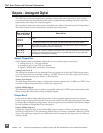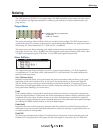
Metering
23
Metering
The 744T features a 76 LED (4 x 19) output meter. The DSP-controlled output meter provides a selec-
tion of ballistics and lighting intensities. In addition, peak indicators on input channels show clip-
ping activity.
Output Meter
0 dBFS track LEDs are programmable
as peak LEDs
(0 dBFS to −20 dBFS)
The meter uses energy effi cient LEDs which are viewable in full sunlight. The 744T output meter is
unaffected by shock or extremes in temperature and humidity. Meter ballistics are setup menu select-
able among VU, Peak, Peak-Hold, VU + Peak and VU + PeakHold.
The meter uses a non-linear metering scale which increases meter resolution in the most important
part of the scale. From −50 to −40 dBFS, each LED segment equals approximately 10 dB. From −40 to
−12 dBFS, each segment equals 2 dB. From −12 to 0 dBFS each segment equals 4 dB.
Meter Ballistics
The output meter can be set to display any of fi ve types of meter ballistics: VU, Peak, Peak-hold,
a combination of VU and Peak, and a combination of VU with Peak-hold. The meter ballistics are
selected in the setup menu.
VU - (Volume Units)
Ballistics correspond closely to how the human ear perceives loudness and provides a good visual
indication of how loud a signal will be. In VU mode, the attack and decay of the meter signal is
300 mS. While giving a very good visual indication of perceived loudness, VU meters gives poor
information on actual signal peaks and are virtually useless for tracking to the 744T. In VU mode, the
front panel meter labeling is in volume units.
Peak
Peak-reading ballistics correspond to actual signal maximums, but don’t necessarily correspond to
perceived signal loudness. A peak meter has a near-instantaneous attack to display maximum signal
amplitude and a slow decay to allow the user to see them. Peak metering is essential for digital re-
cording, since signal overload can cause immediate distortion. The peak meters front panel markings
are calibrated in dBFS, decibels relative to full scale digital signal.
Peak Hold
Essentially the same as Peak metering where the peak level indication will hold for the peak level
indication for several seconds. Peak-hold indicators are useful for metering in applications when an
overload condition is unacceptable.
Peak/VU
The meter can simultaneously display VU and Peak level information. In this mode the perceived
loudness (VU) is displayed on a bar graph, and the Peak signal on a dot above the VU. With this


















